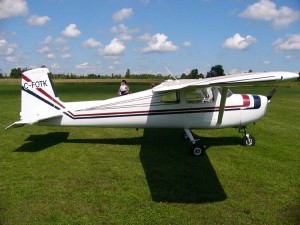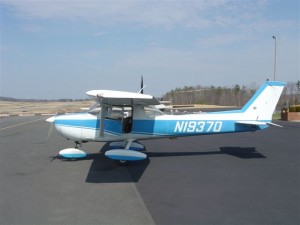If you go to an airshow featuring Naval Aviators, you may see one or two of the more experienced pilots walking around with patches on their flight jackets proclaiming, “1000 hours” or “2000 hours” in a particular tactical aircraft. I came close with the A-4 Skyhawk, logging just a little more than 750 hours.
The one airplane I did log more than 1000 hours in as the venerable Cessna 150. It is the only airplane I have logged that much time in and I must say, it is a fine airplane. Most Cessna 150s spent the majority of their lives in flight schools allowing student pilots to beat them up practicing landings. Some were lucky enough to find homes with pilots who cherished and took care of them. Even then, they were used to some degree in teaching people how to fly.
When the 150 came out in 1959, she had a straight tail like her bigger brother the Cessna 172. Sporting a straight back fuselage without the wraparound rear window, the airplane flew faster than later models because of less drag. With a 100-horsepower O-200 Continental engine, the little airplane would deliver an honest 100 miles per hour on 6 gallons of 80-octane fuel.
Most 150s weigh in a little over 1100 pounds, giving the aircraft about 450 pounds or so of useful load. With 24.5 gallons of fuel, this typically left approximately 400 pounds available personnel and baggage. Flying characteristics for the Cessna 150 were very honest. In teaching young pilots how to fly, the airplane was unmatched in the 1960s and 70s. Over the course of the production life of the airplane, Cessna manufactured a little more than 20,000 units. Today, according to Trade-A-Plane, pilots can find good Cessna 150s on the used airplane market for prices ranging from $15,000 to a little over $35,000.
Dollar for dollar, it is hard to beat the Cessna 150 in terms of utility and flying fun. It is a good flying, safe, and economical airplane. A family could purchase a Cessna 150 and every one could learn how to fly in the airplane.
If the airplane cost $25,000, was stored in a hangar for $200 a month, and everyone in the family shared in operating costs to learn how to fly, the per hour operation costs could be held as low as about $40 per hour. In today’s high cost environment, that’s a pretty good deal.
And there is little doubt everyone in the family would have fun taking care of and flying one of the littlest Cessnas.
-30-
(This post is for Jeanne and everyone else who loves the 150.)
© 2010 J. Clark




Thanks Joe! I’m planning on taking my husband and I up in 4872B next week. We are going to fly from St. Cloud to Duluth and then on to Madeline Island near Bayfield Wisconsin for my first attempt at an island landing.
I’m trying to find a day weather wise that will work for all the airports since flying near Lake Superior can be tricky at times. So far if the weather is good in St. Cloud its not great in Duluth and Bayfield and vice versa. Hopefully later in the week.
I’ve been checking out the ads almost daily for a plane of my own.
Pingback: 100,000 Airplanes |